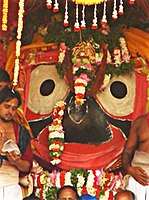Ratha Yatra (Puri)
Ratha Yatra (/ˈrʌθə ˈjɑːtrə/) (also called as Car Festival or Chariot Festival) is a Hindu festival associated with Lord Jagannath held at Puri in the state of Odisha, India. It is the oldest Ratha Yatra taking place in India and the World, whose descriptions can be found in Brahma Purana, Padma Purana, and Skanda Purana and Kapila Samhita.[1]
| Rathayatra of Puri | |
|---|---|
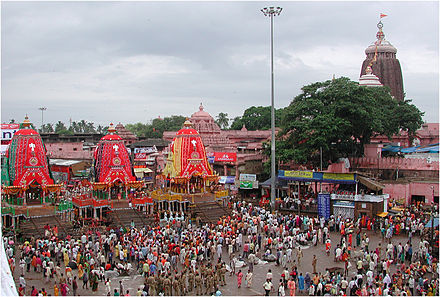 Three chariots of the deities with the Temple in the background, Puri | |
| Also called | Ghosa Jatra |
| Observed by | Hindu |
| Type | Religious |
| Begins | Ashadha Shukla Dwitiya |
| Ends | Ashadha Shukla Dashami |
| 2019 date | 4 July |
| 2020 date | 23 June |
| 2021 date | 12 July |
| 2022 date | 1 July |
| Frequency | annual |
_09.jpg)
This annual festival is celebrated on Ashadha Shukla Paksha Dwitiya (second day in bright fortnight of Ashadha month).
The festival commemorates Jagannath's annual visit to Gundicha Temple via Mausi Maa Temple (maternal aunt's home) near Saradha Bali, Puri.
Description

Ratha Jatra, the Festival of Chariot: Chariots of Shri Jagannath is celebrated every year at Puri, the temple town in Odisha, on the second (dwitiya) day of shukla pakhya (waxing cycle of moon) of Ashadha Maasa (3rd month in Lunar Calendar). The presiding deities of the Jagannath Temple, Puri's main temple, Lord Jagannath, Lord Balabhadra and Goddess Subhadra, with the celestial wheel (Sudarshana Chakra/ସୁଦର୍ଶନ ଚକ୍ର ) are removed from the temple in a ceremonial procession to their chariots. The huge, colourfully decorated chariots are drawn by multitude of devotees on the bada danda, the grand avenue to the Gundicha Temple (Gundicha – King Indradyumna's Queen), two miles away to the North. On the way the chariot of Lord Jagannatha, Nandighosa (ନନ୍ଦିଘୋଷ) waits near the crematorium of Bhakta Salabega (ଭକ୍ତ ସାଲବେଗ) a Muslim devout to pay him tribute.
On their way back from the Gundicha Temple, the three deities stop for a while near the Mausi Maa Temple (Aunt's abode) and have an offering of the Poda Pitha, which is a special type of pancake supposed to be the Lord's favourite. After a stay for seven days, the deities return to their abode.
The Chariots
The three chariots of Jagannath, Balabhadra and Subhdra are newly constructed every year with wood of specified trees like phassi, dhausa, etc. They are customarily brought from the ex-princely state of Dasapalla by a specialist team of carpenters who have hereditary rights and privileges for the same. The logs are traditionally set afloat as rafts in the river Mahanadi. These are collected near Puri and then transported by road.
The three chariots are decorated as per the unique scheme prescribed and followed for centuries stand on the Bada Danda, the Grand Avenue. The chariots are lined across the wide avenue in front of the temple close to its eastern entrance, which is also known as the Sinhadwara or the Lion's Gate.
Around each of the chariots are nine Parsva devatas, painted wooden images representing different deities on the chariots' sides. Each chariot has a charioteer (Sarathi) and four horses.
| Chariot Details | Jagannath | Balabhadra | Subhadra |
|---|---|---|---|
| Name of Chariot | Nandighosha (ନନ୍ଦିଘୋଷ) | Taladhwaja (ତାଳଧ୍ୱଜ) | Darpadalana (ଦର୍ପଦଳନ) |
| Alternates name of Chariot | Garudadhwaja, Kapiladhwaja | Langaladhwaja | Devadalana, Padmadhwaja |
| Image | 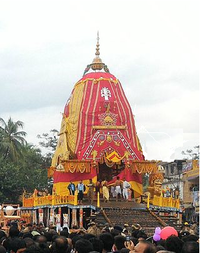 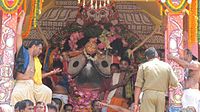 |
  |
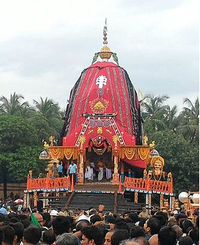  |
| Number of wheels | 16 | 14 | 12 |
| Total Number of wooden pieces used | 832 | 763 | 593 |
| Height | 44' 2" | 43' 3" | 42' 3" |
| Length and breadth | 34'6" x 34'6" | 33' x 33' | 31'6" x 31'6" |
| Colours of the canopies | Red, Yellow
(yellow associated with Vishnu) |
Red, Bluish green | Red, Black
(Black associated with the Goddess) |
| Guardian | Garuda | Vasudev | Jayadurga |
| Charioteer | Daruka | Matali | Arjuna |
| Flag name | Trailokyamohini | Unnani | Nadambika |
| Flag emblem | Palm Tree | ||
| Name of Horses |
|
|
|
| Colour of Horses | White | Black | Red |
| Name of Chariot Rope | Sankhachuda Nagini | Basuki Naga | Swarnachuda Nagini |
| Accompanying deity | Madanmohan | Ramakrishna | Sudarshana |
| Gatekeepers (Dvarapala) |
|
||
| Nine parshvadevata (Subsidiary deities) |
Chandana Jatra
The construction of the chariots starts on Akshaya Trutiya, the third day of the bright fortnight of Vaisakha, with ritual fire worship. This takes place in front of the palace of the King of Puri and opposite the main office of the Puri temple. On this day, the new agricultural season starts and farmers start plowing their fields. This day also marks the beginning of the summer festival of the deities, also known as the sandalwood festival or Chandan Yatra, which lasts for three weeks. In this festival, the representative images of the presiding deities are taken out in colorful processions and given a ceremonial boat ride in the Narendra pokhari/tank every day. In an interesting demonstration of the assimilative character of the Jagannatha cult, Madanmohana and Rama-Krishna, representing Jagannatha & Balarama partake in the festival with the representatives' images of the presiding deities of five main Shiva temples of Puri. These are curiously known as Pancha Pandava, the five brothers of the Mahabharata story. Later the deities have a ritual bath in a small temple in the middle of the tank, in stone tubs filled with water, sandalwood paste, scents, and flowers.
This sandalwood festival culminates in the Snana Yatra, the Bathing Festival on the full moon day of the month of Jestha. On this day, the presiding deities descend from their seats on an elevated platform in the sanctum sanctorum, the bejeweled throne. They are bathed in 108 pots of water brought from the suna kua, the golden well and assume the elephant form on the special bathing platform, close to the Eastern boundary wall of the temple. From that day the deities remain in symbolic and ritual convalescence for about two weeks. They are barred from the view of the ordinary devotees. Only three special patta chitras, traditional Oriya paintings of natural colors on cloth stiffened with starch, known as Anasara Pattis, are strung on a bamboo screen hiding the deities from public view, can be seen by the public. During this period, the deities are given only roots, leaves, berries and fruits to cure them of their indisposition. This ritual is a reminder of the strong tribal elements in the genesis and evolution of the Jagannatha cult. The progeny of Lalita, daughter of the original tribal worshipper Biswabasu, chieftain of hunters, and the Brahmin priest Vidyapati, are known as daitapatis or daitas. They have the almost exclusive privilege of serving the Lord during the convalescence and through the entire period of Ratha Jatra or the Festival of Chariots.
Suna Besha(ସୁନା ବେଶ)
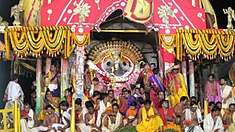
After the chariots of the deities return to the main temple from the Gundicha temple, the deities are attired in gold ornaments and worshipped on the chariots. This celebration is known as Suna Besha. Tradition maintains that this event was first started by King Kapilendra Deb in 1460, when after returning victorious from war he donated gold to Jagannath.[2] The deities are adorned with gold jewelry weighing nearly 208 kg. In 2014 nearly nine hundred thousand devotees witnessed this event held on 9 July[3]
The Ratha Yatra and Pahandi of 2015
Lakhs of devotees thronged the coastal town of Puri to catch the glimpse of deities re-embodied after 19 years on chariots on the occasion of Rath Yatra, marking largest-ever religious congregation in Odisha.
International Ratha Yatra
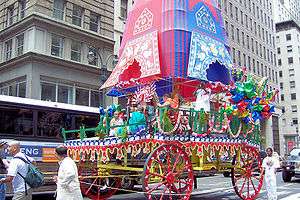
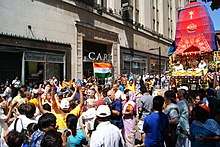
The Ratha Yatra festival has become a common sight in most major cities of the world since 1968 through the ISKCON Hare Krishna movement. By the mercy of Mahaprabhu Shri Jagannath and Chaitanya, A. C. Bhaktivedanta Swami Prabhupada had successfully transplanted the festival which now happens on an annual basis in places all over the world in over 108 cities including; Moscow, New York, Houston, Atlanta, London, Rome, Zürich, Kolkata, Mumbai, Karachi, Berlin, Heidelberg, Cologne, Florence, Wroclaw, Sydney, Perth, Kampala, Nairobi, Mombasa, Kisumu, Mexico City, Dublin, Belfast, Manchester, Birmingham, Alchevsk, Buenos Aires, Madrid, Stockholm, Bath, Budapest, Auckland, Melbourne, Montreal, Paris, Copenhagen, Amsterdam, Los Angeles, Toronto, Vancouver, Santiago, Tallinn, Lima, Antwerp, Sofia, Kuala Lumpur, Oslo, Zhongshan, Myitkyina, Bangkok and many other cities.[4] The Ratha Yatra in Dhamrai, Bangladesh, is one of the most important in Bangladesh.
Ratha Yatra dates
This table shows the dates for Ratha Yatra held in Puri, Odisha. These dates shows from the Year Nabakalebara, 2015 to the Year of next (After 19 years) Nabakalebara, 2034.
| Ratha Yatra in Puri | ||
|---|---|---|
| Year | Starting Date | Ending Date
(Ashadha Shukla Dashami) |
| 2015 | 18th of July | 26th of July |
| 2016 | 6th of July | 14th of July |
| 2017 | 25th of June | 3rd of July |
| 2018 | 14th of July | 22nd of July |
| 2019 | 04th of July | 11th of July |
| 2020 | 23rd of June | 30th of June |
| 2021 | 12th of July | 19th of July |
| 2022 | 1st of July | 9th of July |
| 2023 | 20th of June | 28th of June |
| 2024 | 7th of July | 16th of July |
| 2025 | 27th of June | 5th of July |
| 2026 | 16th of July | 24th of July |
| 2027 | 5th of July | 13th of July |
| 2028 | 23rd of June | 1st of July |
| 2029 | 13th of July | 20th of July |
| 2030 | 2nd of July | 10th of July |
| 2031 | 22nd of June | 30th of June |
| 2032 | 9th of July | 18th of July |
| 2033 | 28th of June | 7th of July |
| 2034 | 17th of July | 25th of July |
Service offerings
Jagannath temple employs different kinds of sevakas who offer their services on the Ratha.
- Suara
- Mahasuara
- Dahuka: Ratha dahuka boli (Odia: ଡାହୁକ ବୋଲି, also "Dahuka gita" (ଡାହୁକ ଗୀତ)) which are poetic recitations. Ratha Yatra being a symbolic expression of fertility and Life cycle, these "boli" sung by the Dahuka contain bawdy songs. It is believed that unless the Dahuka boli is sung 'Ratha' does not move.[5] These songs are sung publicly without any kind of hold on the lyrics.[6] Dahuka controls the movement of Ratha during the festival.[7][8]
- Daita pati
- Puspalaka
- Banati Players: Banati is an age-old art, in which a person spins balls set on fire and tied to the ends of a rope. Every year during the Rath yatra devotees perform "Banati" to appease Lord Jagannath.[9] Knives and fireballs, which are attached to the Banati add colour to the procession of the Lord as it reaches its destination
See also
References
- "About Puri Rath Yatra : Jagannath Rath Yatra". RathYatraLive. Retrieved 4 June 2016.
- "Jagannath glitters in golden get-up". Times of India. 9 July 2014. Retrieved 13 July 2014.
- "Jagannath glitters in golden get-up". Times of India. 9 July 2014. Retrieved 13 July 2014.
- Festival of India
- Ethnographic and Folk-Culture Society (Lucknow, India) (2001). The Eastern anthropologist, Volume 54. Lucknow, India.
- Surendra, Mahanty (1982). Lord Jagannatha: the microcosm of Indian spiritual culture. Bhubaneswar, Orissa: Orissa Sahitya Akademi. p. 93.
- B. B. Jena (1980). Orissa, people, culture, and polity. Kalyani Publishers. p. 313. Retrieved 26 March 2012.
- Sarat Chandra Mahapatra. Car Festival of Lord Jagannath, Puri. Puri, India: Sri Jagannath Research Centre (Purī, India). Retrieved 26 March 2012.
- ""Banati" players perform martial art ode to Lord Jagannath". Hindustan Times, Delhi – via HighBeam Research (subscription required) . 27 June 2006. Archived from the original on 1 June 2013. Retrieved 15 September 2012.
External links
| Wikimedia Commons has media related to Rath Yatra. |
